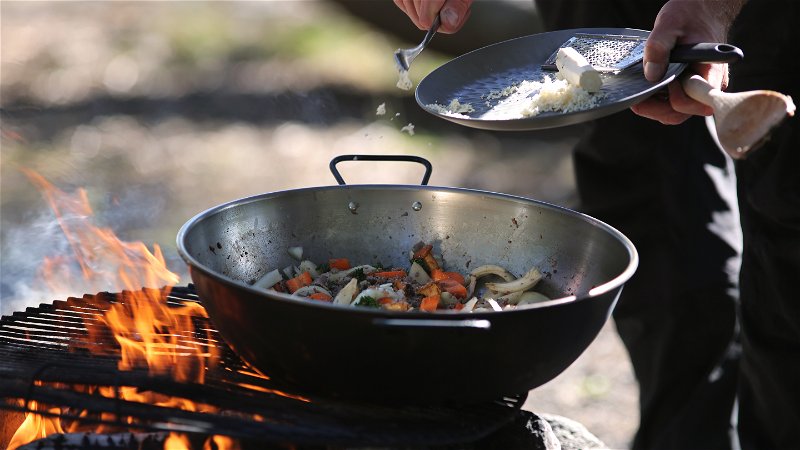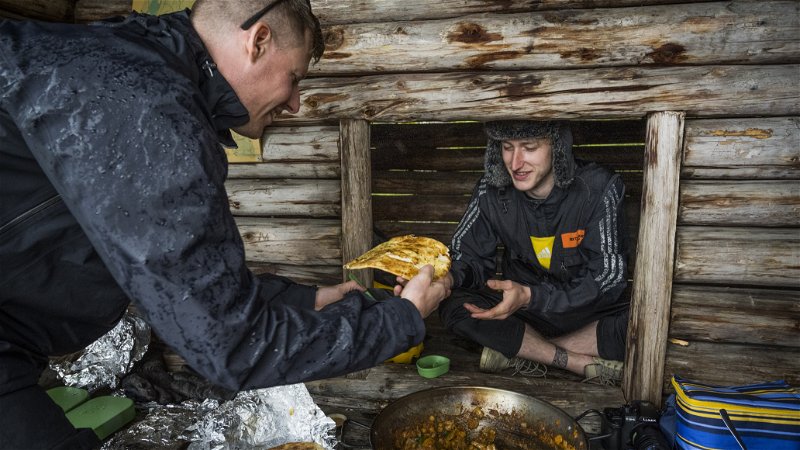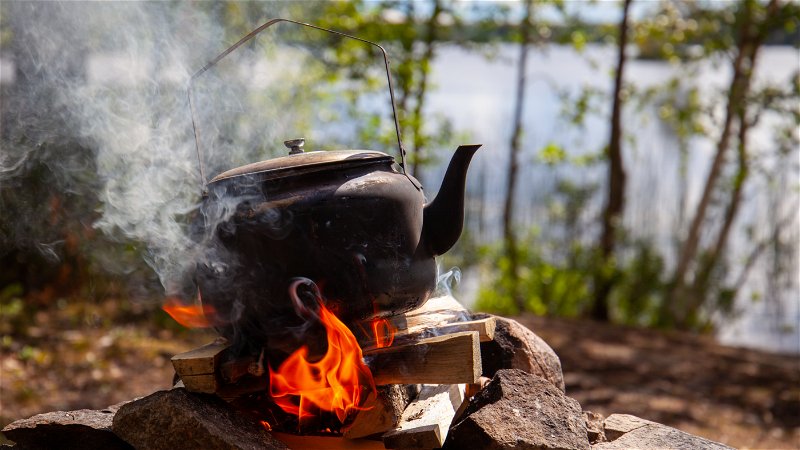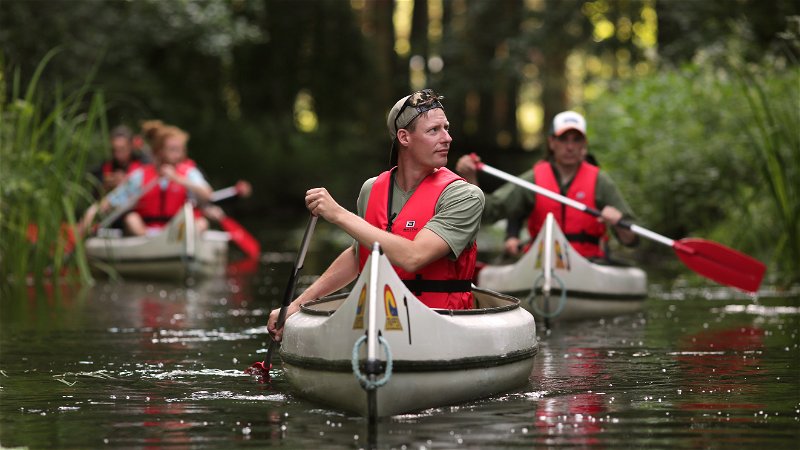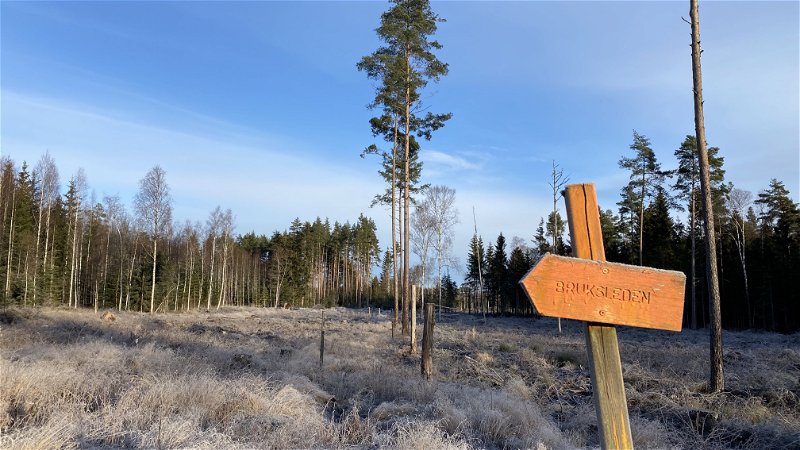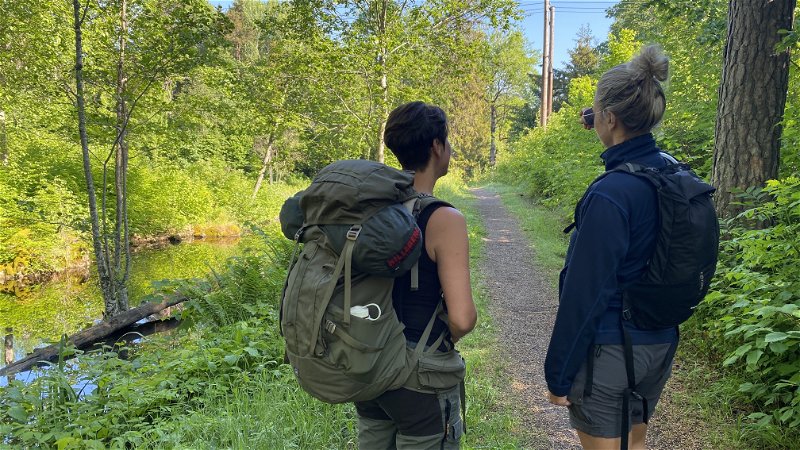Cooking outdoors: what to know & what recipes to make
Hot meals can be the best part of camping trips & anyone can be an outdoor chef!
Enjoying a meal that you’ve prepared in the open air of nature is often a highlight of any outdoor stay. Cooking outdoors is surprisingly fun, the food usually seems more appetising, and being an outdoor chef is easier than you think!
In this article, you'll find essential advice for anyone new to cooking outdoors. There are tips on the different approaches and, of course, some tasty recipes (at the end of the piece) to try the next time you’re camping.
The basics of cooking while camping
The big difference between cooking outdoors and cooking at home is the absence of a fully equipped kitchen. When you cook food while camping, you have to carry everything you need and therefore have to think about each ingredient and piece of gear. You need to consider what you actually have to pack and what you can leave behind, usually by being a little creative. Does the meal require fresh onion, or can onion powder work? Is a cutting board essential, or can you cut against a plate? Do you have enough plates? By asking yourself these questions ahead of time, you can not only make cooking at your campsite easier but transporting everything there as well.
The right cooking gear for camping
In addition to minimising the amount of kitchen equipment to carry, you should also think about what kind of kitchen equipment to bring. A cast iron pan does a great job distributing heat, but it is very heavy. Aluminium cookware is lightweight but not very durable. Stainless steel is a good middle-ground choice.
In addition to the material making up your kitchen gear, its shape is also important. A pan that’s too flat easily drops a large amount of food into the fire when it’s moved around. A wok can keep more food from sloshing out, but it's more difficult to pack. As with much other outdoor equipment, picking the right cooking gear for camping is about compromise.
Dehydrate your food beforehand
If you are going for a hike and want to lighten the load of your pack, consider drying your meals before your trip. You can use a regular oven, like those in most homes, to dehydrate prepared dishes as well as individual ingredients such as meat, fish and vegetables. For example, you can dehydrate a normal minced meat sauce at home by spreading the finished sauce on a plate with baking paper. Then, heat it overnight at 50° C using a small spoon to keep the oven door ajar for extra ventilation. You can find a slew of tasty dishes to prepare and dehydrate at home. All you need to do is mix the food with hot water when you’re ready to eat on the trail!
Cooking over fire
If you are going to cook over an open fire, the first thing to think about is fire safety. Read all about fire safety and using campfires in the great outdoors. You can learn about different ways to build and maintain a fire when camping.
The advantage of cooking over an open fire is that you can fit several large pans. So you can cook for a large group if you have a large enough campfire. The challenge of cooking over fire is maintaining a consistent temperature. You can control the temperature by either keeping the flames at a steady level or by regularly adjusting the distance between the fire and the cookware.
A camping grill is great for something to put your cookware on. Of course, it is possible to put a pot or pan directly on the fire, but this often makes it too hot. A camping grill, on the other hand, can be raised and lowered in height with rocks and other materials.
Cooking with camping stoves
If you don't want to cook your food over an open fire, the best alternative is a camping stove. A classic camping stove is Trangia’s line of alcohol-burning portable stoves. These days, however, gas has replaced alcohol as the main type of fuel for most camping stoves. A gas stove is easy to start, regulates heat, and leaves no soot behind. Most outdoor sporting goods stores now sell as many different types of gas camping stoves as a grocery store’s selection of shampoos. If a new camping stove is on your shopping list, the most important thing to remember is to buy one that’s the right size for your needs. Gas camping stoves now come with one to four burners for cooking.
Respect the surrounding nature
Most people know that you shouldn’t just throw plastic, glass or metal into the woods. These materials aren’t broken down by natural elements and can remain for generations. On the other hand, many people don’t know that food waste isn’t broken down immediately. It can stick around, rotting, for months. So be a considerate camper and remember the following:
- Do not dispose of your food waste directly in the wild. Dig a small pit far away from the hiking trail for disposing of your food waste and bury it before you leave.
- Do not wash your cookware directly in a lake or stream. Put water in a container to wash your cooking gear, then dump out the dirty dishwater in your food waste pit or somewhere it won’t disturb others. Nobody wants to swim with your leftover macaroni pasta.
Recipes
The Internet is full of smart recipes for outdoor cooking. Here are some favourites to get you started.
Indian curry with grilled naan bread
This is a recipe developed and refined in the forests surrounding the Gruvdammsrundan trail in Sala. It’s a meal that requires some work, but it’s good for larger groups and is easy to cook in a large pot.
Time: About 1 hour
Ingredients for 4 people:
- 2-3 tablespoons of cooking oil
- 1 packet of spice mix - Santa Maria’s Garam Masala
- Salt and chilli seasoning
- 1 large yellow onion
- 2 cloves of garlic
- 1 small piece of ginger
- 1 handful of fresh coriander
- 1 yellow bell pepper
- 1 small broccoli
- 8 medium mushrooms
- 1 bag of fresh spinach leaves
- 1 can of crushed tomatoes (400 g)
- 1 can of boiled chickpeas (320 oz)
- 1 can of Mango Chutney
- 1 small can of Creme Fraiche
- package of 4 pre-baked naan bread (Santa Maria’s)
What you need:
- Fire
- A large pan, e.g. a pot, wok or saucepan
- A cooking spoon
- A knife with a cutting board
- Grilling or oven gloves
- Camping grill for the naan bread
- Plates/camping mugs
- Cutlery/sporks
Cooking:
- Since this dish requires a fairly large pot, it’s best cooked over an open fire and not a camping stove. Start by building the fire and letting the fire burn down to a suitable size. The size depends on whether you have a grill to place your cookware on. If you have to place the cookware directly in the fire, wait until the flames die down and only a sturdy bed of glowing embers remain.
- Finely chop the onion, garlic, and ginger. Chop the mushrooms, bell pepper, and broccoli into any large pieces, but consider they’ll be eaten with bread.
- Start by frying the onion in the oil. Check that the temperature is not too hot and that the onion isn’t burned. Adjust the distance of the cookware to the fire.
- When the onion has become slightly shiny, add the garlic and, shortly after, the spice mix and ginger. Stir everything around.
- When the mix has fried for a minute, add the bell pepper, mushrooms, and broccoli.
- When the vegetables have fried for a bit (the time depends on the temperature), add the crushed tomatoes.
- Cook the pot until the vegetables have a desired consistency. If necessary, add about a deciliter of water.
- Add the salt and chilli seasoning to suit your preference.
- Add the pre-cooked chickpeas and the spinach leaves just before you feel the pot is ready.
- Chop the fresh coriander and add directly to the pot or leave to serve on the side.
- Toast the prepared naan bread on a grill over the glow until it has a lovely brown surface.
Serving:
Serve with the creme fraiche and mango chutney on the side. Diners are encouraged to dip the naan bread in the curry!
Slacker’s mushroom risotto
This is a classic for anyone who needs to cook something quick and easy.
Time: 10 minutes
Ingredients:
- Instant rice
- 1 can of mushroom soup
- Water
- Option: Use risoni, a pasta that’s shaped like grains, instead of instant rice.
What you need:
If you use instant rice, you can prepare it with just a food container and a thermos of hot water. If you use risoni pasta, it needs to boil for about 10 minutes. So you’ll need to cook it in a pot on a camping stove or over an open fire.
Cooking:
Bring the mushroom soup to a boil. Add an appropriate amount of instant rice or risoni, which has already been cooked according to its instructions.
Serving:
Eat with a spoon directly from the pot.
Gourmet chef’s mushroom risotto
Here's a recipe for those of you who don't mind adding some extra ingredients to get that extra flavour boost.
Time: Approx. 30 min.
Ingredients for 2 people:
- 1-2 tablespoons of olive oil
- 1.5 dl of rice
- 1 shallot
- 1 clove of garlic
- 10 g of dried mushrooms (or about 100 g of fresh mushrooms)
- 2.5 cups of mushroom broth (half a bouillon cube)
- Parmesan cheese
- A dash of dry white wine
Equipment:
The dish can be prepared in a pot over an open fire or on a camping stove. In addition, you need a small bowl or container in which to mix the broth. If you haven't cut the onions and mushrooms at home, you also need a knife and something to cut against.
Cooking:
- Soak the dried mushrooms before cooking (if you’re not using fresh mushrooms).
- Gently fry the chopped onion and mushroom with oil in a pan.
- Pour in the rice and the wine and slowly fry while stirring.
- Gradually add in the broth.
- After about 15 minutes, it should be slightly mushy and sticky.
- Finish off by sprinkling the Parmesan cheese and adding some extra olive oil (if necessary).
Serving:
Ideally, serve this dish in a hand-carved wooden bowl with a wooden spoon. It’s best enjoyed with a glass (or, in this case, a camping mug) of cool, dry wine.
Bon appétit!
